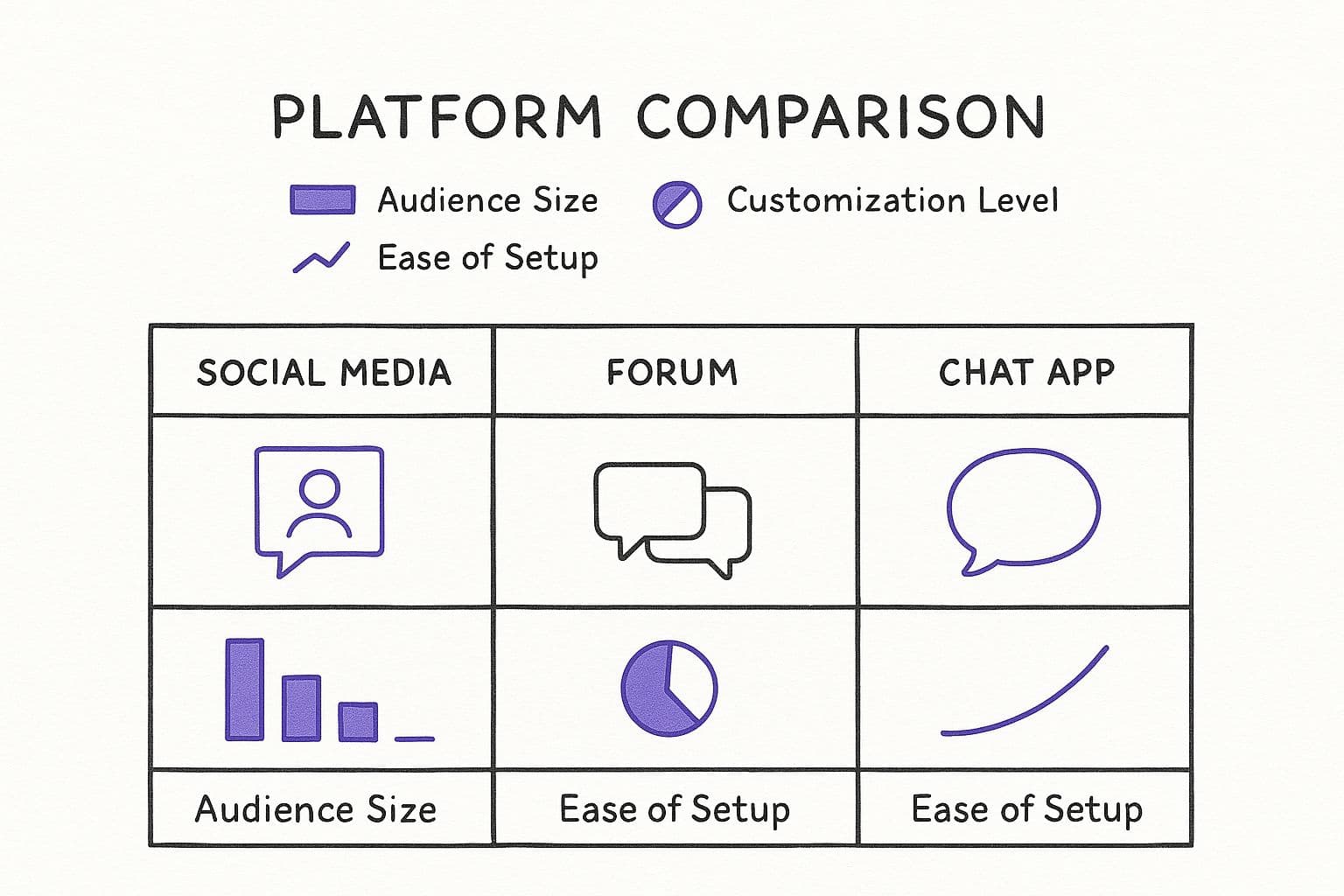Understanding What Makes UK Communities Actually Thrive
Let’s get one thing straight. The UK is packed. A staggering 67.8 million of us are online, which is 97.8% of the entire population. You'd think launching a community here would be a walk in the park. It’s not.

1d21eadd-2a31-40fc-bd40-b0942bdfd20e.jpg
That massive audience means the digital space is incredibly noisy. Just being online isn't enough. To build an online community that actually sticks, you have to forget chasing vanity metrics and focus on creating real depth and connection. The sheer volume of choice has made Brits sharp critics of online fluff.
This crowded market has created a unique online culture in the UK. We’re less impressed by flashy self-promotion and more interested in genuine, valuable conversations. And that, right there, is your biggest advantage. You can find more detailed stats on the UK's digital habits in the latest DataReportal study.
To put the market size into perspective, here's a quick breakdown of the numbers you're working with.
UK Internet Usage Demographics
Breakdown of internet penetration and user growth in the UK market
| Metric | Value | Growth Rate |
|---|---|---|
| Internet Users | 67.80 million | +0.1% year-on-year |
| Internet Penetration | 97.8% of total population | - |
| Social Media Users | 57.40 million | +2.0% year-on-year |
These figures show a market that is almost fully saturated. While social media use is still growing slightly, the slow growth in overall internet users means your battle isn't for new users, but for the attention of existing ones.
The Shift from Promotion to Peer-to-Peer Connection
If you’ve ever rolled your eyes at an overly polished, sales-heavy post, you get the British online psyche. We have a world-class BS detector, especially for the hard sell. This is precisely why communities built around a single "guru" or brand personality often fail to build deep roots.
The real magic happens when the spotlight moves away from a top-down broadcast and onto a web of peer-to-peer connections. People aren't just looking for an expert to follow; they're looking for their tribe. They want to connect with others who get their specific struggles, passions, and sense of humour.
For example, a group for UK-based classic car enthusiasts doesn't thrive because of one all-knowing leader. It thrives because a member in Cornwall can get practical advice on a rusty chassis from someone in the Cairngorms. That shared experience is the foundation, making the members—not the founder—the true stars of the show.
Key Traits of Flourishing UK Communities
So, what separates a community that becomes a daily habit from one that’s dead in a week? After talking with dozens of successful British community builders, a few clear patterns emerge. They don't rely on growth hacks; they lean into cultural truths.
A community that actually lasts is built on:
- A Clear, Shared Purpose: This goes way beyond a broad topic. Instead of a generic "fitness" group, a winning community focuses on something like "Marathon Training for Busy London Parents." That specificity creates an instant bond over a shared, very real challenge.
- Authentic, Understated Leadership: The best community leaders act more like a good pub landlord than a loud stage performer. They facilitate chats, make introductions, and gently guide the conversation without dominating it. Their value is felt in their helpfulness, not their volume.
- A Culture of Quality Conversation: Empty "Great post!" comments are the enemy of connection. Thriving communities encourage thoughtful replies and even respectful debates. They create a safe space where it’s okay to ask "silly" questions, which leads to much deeper relationships.
- Prioritising User-Generated Value: The most energetic communities are powered by their members. The leader’s job is to create prompts that get people sharing their own stories and expertise. It’s the difference between asking, "What do you think of this product?" and asking, "Share a photo of your biggest gardening disaster this year." The second option invites personal stories and real connection, creating a rich community fabric.
Finding Your Community's Digital Home
Choosing where to build online community is one of the most important decisions you'll make. Get it wrong, and you're building on quicksand. It's not just a tech choice; it's about picking the right room for your conversation. This one decision sets the tone, defines who you attract, and shapes how members interact.
Think of it like choosing a venue. A loud, crowded pub creates a totally different vibe from a private members' club. Some UK community managers chase the massive user numbers on platforms like Facebook Groups or LinkedIn, hoping to tap into a ready-made audience. But they often find themselves battling noisy algorithms and endless distractions that kill real connection.
Weighing Your Options: Reach vs. Control
The big trade-off you face is between platforms that offer built-in discovery and those that give you a focused, private space. Building on a big social media platform is like setting up a shop in someone else's mall. You get plenty of foot traffic, but you have to play by their rules, and they can change the layout overnight. You're constantly fighting for attention on rented land.
On the flip side, dedicated chat apps like Telegram or Discord feel like your own private club. Here, members can connect without the noise of a public feed. For many, this is where genuine relationships are built, making it the perfect foundation for a paid community where access and value are everything.
To give you a clearer picture, here’s a quick comparison of the most common platforms for UK communities.
Platform Comparison for UK Communities
A detailed comparison of popular platforms for building online communities in the UK
| Platform | Best For | UK User Base | Key Features | Cost |
|---|---|---|---|---|
| Facebook Groups | Broad reach, local communities, easy discovery | ~45 Million+ | Events, polls, live video, marketplace integration | Free (You pay with data and ad competition) |
| Telegram | Paid subscriptions, direct communication, privacy-focused users | ~15 Million+ | No algorithm, channels & groups, bots, 2GB file sharing | Free |
| Discord | Gaming, tech, and highly engaged niche communities | ~7 Million+ | Voice/video channels, advanced roles & permissions, server customization | Free (Nitro subscription for user perks) |
| Small, private groups (friends, family), direct updates | ~40 Million+ | End-to-end encryption, simple interface, status updates | Free |
The key insight here is simple. If you need mass-market discovery and can handle the algorithmic chaos, social media has its place. But if you're building a premium experience where direct access and control are non-negotiable, focused apps are the clear winner.
This simple breakdown shows the core trade-off: social media is great for getting eyeballs, but focused chat apps are where you build real loyalty.

6e706b7a-f412-4e28-8813-0fd7d04573c5.jpg
There’s no single ‘best’ platform. Social media is an audience-building machine, while chat apps give you superior control and a direct line to your members.
The Telegram Advantage for Paid Communities
For creators who want to monetise their community, Telegram is a game-changer. Its real power is its directness. There's no algorithm to outsmart; when you send a message, your members get it. This unfiltered communication is critical when people are paying you for content and access.
The platform's simplicity is its greatest asset. It’s designed for conversation, the lifeblood of any community. For a subscription-based group, this lack of distraction is a core part of your value. Members pay for a premium, focused experience, not to get hit with ads or unrelated posts. This setup is a fantastic middle-ground, and if you're curious about the more traditional route, you might be interested in our guide on how to create a membership site from scratch.
Ultimately, your platform choice should come down to a few key questions:
- Member Habits: Where do your ideal members already spend their time online? Don’t make them learn a new platform unless you have a very good reason.
- Content Style: What are you sharing? Is it quick text updates, detailed video guides, or live audio chats? Make sure the platform supports your content style effortlessly.
- Future Scalability: Think about moderation tools and monetisation from day one. Trust me, having to migrate a buzzing community because you outgrew your platform is a nightmare you want to avoid.
Attracting Your First Champions and Core Members
Forget about getting your first hundred members. Your first ten are the only ones that truly matter. These people aren’t just numbers to fill a chat; they are your founding champions. They’re the ones who will set the vibe for everything that comes after.

fb37e6f4-6036-43ac-b1c6-38ebfcf2fc24.jpg
Nailing this first step is what separates a group that buzzes with life from one that’s a ghost town. When you build an online community on a solid foundation of the right people, growing it later feels almost automatic.
Identifying Your Founding Members
Don't just blast a link out to the world. Your first members need to come from your inner circle—the people who already know, like, and trust you. This isn't about mass-messaging everyone you know. It's a hand-picked, strategic process.
Think about:
- Past clients who were thrilled with your results.
- Colleagues whose opinions you genuinely respect.
- The people who always leave insightful comments on your social media posts.
That generic "Join my new community!" post is a guaranteed way to launch to the sound of crickets. A personal, thoughtful message is what gets results. For example: "Hey Sarah, I'm launching a private Telegram group for UK-based entrepreneurs dealing with their first hire. Your posts on LinkedIn about team culture are always spot-on, and I think you’d be an amazing voice to have in there from the start. Would you be interested in being a founding member?"
See the difference? This makes people feel selected, not spammed.
The Art of the Personal Invitation
That personal touch is what separates you from the noise. Your invitation is your first real piece of community content. It needs to tell a story. Explain why this community needs to exist and, more importantly, why them. Why would their specific voice make it a better place?
You're not just asking them to join a group; you're inviting them to help build it. This shift in framing is everything.
This isn't just a gut feeling; the data shows people are desperate for this kind of connection. Across the UK, interest-based groups are exploding. Just look at Reddit, which saw its reach among UK adults jump by 47% year-over-year by mid-2024. A staggering 71% of 18-24-year-olds are on the platform, proving people crave niche, real conversations. Your personal invitation plugs directly into that desire. You can explore more UK social media trends here.
Launch Content That Sparks Conversation
Once your first champions are in, your job isn't done. The goal on day one isn't to celebrate the member count; it's to get people talking. Your very first post should be an open invitation to jump in, not just a passive "Welcome!" message.
Pose a question or a challenge that's impossible to ignore. For a community of UK-based novelists, you could start with a prompt like: "What's the single worst piece of writing advice you've ever received (and thankfully ignored)?"
This kind of opener gets right to the heart of their shared experience. It encourages people to be real and connect on a deeper level from the very first interaction.
With an engaged core, your community finally has a heartbeat. Now you can shift your focus from careful, manual seeding to more intentional growth. The principles for growing a community often mirror those for expanding an audience, and you can find some great ideas in guides on how to grow newsletter subscribers.
As you get ready to open the doors to more people, applying proven membership growth strategies will help you scale up without losing the special spark you created with your founding champions.
Creating Conversations That Matter
The biggest mistake you can make when you want to build an online community is thinking that a busy feed equals a connected group. A feed full of your posts is a broadcast channel, not a community. Real connection comes from starting the conversations people are dying to have. It's less about posting all the time and more about posting things that get people talking to each other.

3f9e0fec-5fe1-45ee-a165-c1502caf2970.jpg
Your role needs to shift from being a content machine to a conversation starter. Your job is to light the spark and then step back, letting the members gather around the fire.
How to Ask Questions People Actually Want to Answer
Forget flat questions like, "What are your goals for this week?". They usually get one-word answers or, even worse, complete silence. A great prompt taps into a shared experience, inviting people to tell stories and feel understood.
For example, in a group for UK property investors, instead of a boring "Any questions about mortgages?", you could ask, "What's the one piece of 'expert' property advice you've heard that turned out to be complete rubbish?" This instantly builds a bond over a common frustration. It sparks war stories, jokes, and genuine advice from peers, which is the heart and soul of any strong community.
Your Content Diet: The Perfect Mix for Engagement
A healthy community can't survive on just one type of content. Your content plan should be like a balanced diet, designed to keep your members engaged and coming back for more. The most successful communities in the UK typically balance three core things:
- Real Value: This is your bread and butter. Share practical tips, actionable advice, and "behind-the-scenes" glimpses into your own work. This shows you're a helpful guide, not just a host trying to fill a feed.
- Human Moments: You don’t need to share your deepest secrets, but showing you’re a real person builds incredible trust. A post about a mistake you made and what you learned is way more powerful than a post about how you've got it all figured out.
- Simple Fun: It can’t all be serious business. A Friday wind-down thread, a poll about a silly industry debate, or a relevant meme can break the tension. This makes your community a place people want to check in on, not one they feel they have to.
Let Your Members Do the Talking
The best communities are powered by their members. Your goal is to create a space where user-generated content (UGC) happens naturally. This not only lightens your content load but also makes members feel more invested in the group's success.
Create regular, structured chances for them to share. A "Feedback Friday" where members can get constructive thoughts on a project or a "Win of the Week" thread are great places to start. When you see members answering each other's questions and celebrating each other's wins, you've built something truly special.
Once you have that internal engine running, you can focus on bringing in a wider audience. If your community is on a professional platform, you'll want to learn how to get more views on LinkedIn to attract new, high-quality members.
Keeping the conversation authentic as you grow is the real test. It requires consistent effort to nurture these member-led discussions, making sure everyone, new and old, finds value in being part of the chat.
Building Trust Through Authentic Leadership

embed
You can feel the difference between a thriving community and a dead one. It’s not about the number of likes or comments—it’s the vibe. When you build an online community, your job changes. You're no longer just a content machine; you become a leader.
Your goal is to create a space where people feel safe, heard, and respected enough to be themselves. This is what separates a noisy, forgettable chat feed from a community people are genuinely proud to be a part of.
Fostering Genuine Connections
Real connections don't spark from generic "introduce yourself" posts. To get past the surface-level chatter, you have to ask better questions. Instead of the usual, try something that hits a little deeper and invites a real story. For instance, "What’s one roadblock you hit this week that only a fellow [group niche] would get?"
That kind of prompt builds instant empathy and shows you're all in it together. Your role here is also to be the master connector. When you spot two members wrestling with the same problem, tag them. A quick note like, "Hey @Jane, you should talk to @Tom about this—he was working through that exact issue last month!" can kickstart a valuable relationship. That’s how your group evolves from a one-way street into a powerful network where members help each other win.
Managing Different Personalities
Every group has its cast of characters. You’ll have the quiet lurkers soaking up information and the dominant voices who have an opinion on everything. Your job is to balance the room so everyone feels like they have a space.
For your lurkers, a gentle nudge can go a long way:
- Tag them in a discussion where you know they have expertise, with a no-pressure out: "No worries if you're busy, but @Chris, you might have some great thoughts on this."
- Shoot them a quick private message thanking them for being there and asking what they'd like to see more of.
With dominant voices, it's all about tactful redirection. Acknowledge their point ("Great insight, Alex, thanks for that!"), then immediately pass the mic: "I'd love to hear what others think about this." This validates their contribution without letting them monopolize the conversation. Balancing these dynamics is a key moderation skill. To keep your approach sharp, it helps to stay current with proven social media marketing best practices.
The Power of Vulnerable Leadership
Nobody connects with a flawless, untouchable leader. Trust is built on authenticity, which means showing you're human. This isn't about spilling your deepest secrets; it's about being real. Sharing a small business mistake you made and what you learned from it is 10x more powerful than pretending you have all the answers.
People don't connect with perfection; they connect with progress. When you're open about your own challenges, you create psychological safety. It sends a clear signal to your members: "It's okay to not be perfect here." This gives them the green light to be honest about their own struggles, which leads to far more supportive and meaningful conversations.
It's a fine line to walk—sharing enough to be relatable without losing your authority. But getting it right is what transforms your group from just another channel into a community that truly matters.
Growing Without Losing Your Community's Heart
Your group is finally blowing up. This is the moment you've been working for, but it's also where most communities start to fall apart. That close-knit, personal magic that attracted your first members can get diluted fast when the numbers climb. Getting through this means making smart choices to scale up without selling out.
Handling growth is the real test when you build an online community. It’s the shift from knowing everyone’s name to managing a crowd, and it demands a completely new playbook.
Scaling Your Culture, Not Just Your Numbers
First, you have to accept you can’t be the host, DJ, and bouncer all at once anymore. This is where moderators come in, but they need to be more than just digital security guards. Think of them as your cultural ambassadors. Don't just pick the most active person; find members who genuinely get the vibe of your community. Their job is to welcome new faces and connect people, not just police the rules.
Imagine a group for UK-based Etsy sellers. A great moderator doesn't just delete spam. They spot a new member asking about postage to the EU and tag a veteran who shared a brilliant solution a few weeks back. They are connectors, not just enforcers. Your guidelines should sound like this, too. Ditch the sterile, corporate rules. Instead of a harsh "No Off-Topic Posts," try something more human: "Let's keep the main chat focused on X, but feel free to pop anything else in our 'cuppa and a chat' channel." It guides behavior without feeling like a lecture.
Keeping It Personal in a Crowd
When your Telegram group swells from 50 members to 500, that cozy pub feeling can quickly morph into a noisy, chaotic train station. To keep that sense of intimacy, you need to create smaller rooms within your big venue. Don't let your community become one overwhelming, single-threaded feed.
A killer strategy is to segment your community into smaller, focused groups or channels. For example, a large community for UK gardeners could have dedicated channels for "Allotment Growers," "Urban Balcony Gardens," and "Pest Control SOS." This helps members find their specific tribe within the larger group, which leads to much deeper connections.
This structure also creates smarter ways to make money. You could offer a premium tier that gives access to an expert Q&A channel or specialized workshops. Finding the right angle is key, and exploring different subscription-based business ideas can give you some fantastic inspiration.
These growing pains aren't signs of failure; they're the symptoms of your success. The key is to address them with purpose. By empowering the right people and structuring conversations thoughtfully, you can scale without the chaos. The most successful UK communities prove it’s entirely possible to grow a large group that still feels like home to every single member.
Your Community Building Blueprint
Alright, enough with the theory. This is the part where the idea in your head becomes a real, buzzing, and profitable Telegram community. Forget vague advice—this is your roadmap. We’ll break down the entire process, from the quiet pre-launch phase to the noisy, exciting first year of growth, all tailored for the UK market.
Pre-Launch Prep: The First Four Weeks
The work you do before a single person joins is what separates successful communities from ghost towns. This month isn't a race to get members; it's about building a solid foundation so that when people arrive, they want to stay.
First, you need to nail your niche. Don't be generic. "UK freelancers" is a dead end. "First-year freelance graphic designers in the UK struggling with client pricing"—now that is a community with a pulse. A sharp focus attracts the right people and, just as importantly, repels the wrong ones. Get this down to a single, powerful sentence.
Next, it's time to assemble your founding champions. Your first 10-20 members are everything. These aren’t random followers; they are your hand-picked allies. Go through your network and find people who genuinely get what you're building. Draft a personal, compelling invite for each one. You’re not just asking them to join a group; you're inviting them to build something special with you.
With your champions ready, you need to build their home. Set up your private Telegram group and immediately connect it to your MyMembers account. This is critical—it automates payments and access right from the start, saving you a massive headache later. Then, draft your community rules, but make them human. Instead of "No spam," try "Let's keep this a space for genuine chat, not sales pitches." Frame it as a shared agreement to make the community great for everyone.
Finally, prime the pump. You need to prepare your first week of content before anyone arrives. These aren't just posts; they are conversation starters. Create at least three killer questions or prompts designed to get your founding members sharing stories and experiences from day one.
The Launch and First 90 Days of Growth
This phase is all about momentum and nurturing conversation. Your focus should be on the quality of interaction, not the quantity of members.
Once you officially launch and onboard your founding champions, your only job for the first month is to spark conversations. The single most important metric is your Active Member Rate. Are people actually talking? A healthy goal is to see 30-40% of your members post or comment within that first month. Forget the total member count—it's a vanity metric at this stage.
After that initial burst, you can start a slow, controlled opening. Don't just blast a public link everywhere. Personally invite new members, using the buzz from your founding champions as social proof. A real quote from a happy member is more powerful than any marketing copy you could write. Keep an eye on your ‘lurker-to-participant’ rate—how quickly a new member feels comfortable enough to join the conversation.
In the UK, a healthy, engaged community often has a daily active member rate of around 10-15%. This is a far better sign of community health than just counting heads.
Sustaining Momentum: Your First Year
Once your community finds its rhythm, your role changes from host to facilitator and strategist.
- Months 4-6: Empower Your Members. Start creating structured ways for members to contribute. A 'Feedback Friday' where people can share their work or a 'Win of the Week' thread are fantastic ways to get everyone involved. This is also the time to spot potential moderators—the members who naturally represent the values of your community.
- Months 7-9: Analyze and Refine. Now you can dive into your MyMembers dashboard with real data. Look at your Monthly Recurring Revenue (MRR) and, more importantly, your churn rate. For a subscription community, a monthly churn rate below 5% is a massive win. It means you're consistently delivering value. Use these numbers to double down on what works and fix what doesn't.
- Months 10-12: Scale with Intention. Growth might mean getting more strategic. Instead of one massive group, think about creating smaller sub-groups for specific topics or launching a premium tier with more direct access to you. This is how you build an online community that scales its revenue without losing that initial spark that made it special.
This blueprint isn’t a magic formula, but it’s a proven path. MyMembers is here to handle the admin, payments, and access control, so you can focus on what truly matters: building connections.
